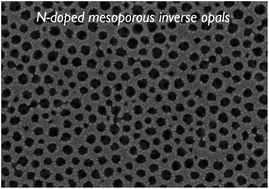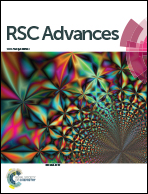N-doped mesoporous inverse opal structures for visible-light photocatalysts†
Abstract
We introduce a new type of doped TiO2 nanostructures, an N-doped mesoporous inverse opal (N-mIO) TiO2 structure as a high-performance visible-light photocatalyst. The mIO TiO2 structure with a 60 nm pore diameter, which possesses a much higher specific area compared with conventional macroporous IO structures, is prepared via a templating approach. The N doping in the mIO TiO2 is achieved via a heat-treatment in the presence of a N-rich precursor. We characterize that the N atom is incorporated in an oxygen-substitution configuration, which effectively narrowed the bandgap of TiO2. We observe that the N doping with a 9.4 wt% doping concentration narrows the bandgap from 3.2 eV to 2.4 eV, which corresponds to light absorption at wavelengths as long as 520 nm. The N doping also changes the surface polarity of TiO2 to a more negative value, which leads to greater adsorption of methylene blue (MB) organic molecules. In the photocatalytic decomposition of MB, the highly N-doped mIO TiO2 exhibits a decomposition rate under visible light exposure that is 4.9 times greater than that of bare IO TiO2. Moreover, compared with the conventional macroporous IO structure, the N-doped mIO exhibits 1.7 times greater activity as a result of its high specific area. We believe this mIO structure can provide a new platform for various electrode applications.


 Please wait while we load your content...
Please wait while we load your content...